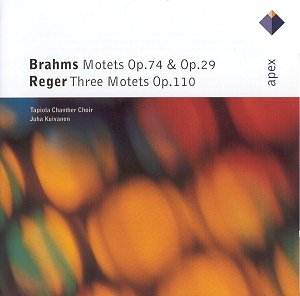
Motets Op.74 and Op.29
Max REGER (1873-1916)
Three Motets Op.110
Tapiola Chamber Choir
Recorded at Olari Church, Finland in November 1996 and May 1997
Crotchet AmazonUK AmazonUS Amazon recommendations
 |
Johannes BRAHMS
(1833-1897) Motets Op.74 and Op.29 Max REGER (1873-1916) Three Motets Op.110 Tapiola Chamber Choir Recorded at Olari Church, Finland in November 1996 and May 1997 |
Crotchet AmazonUK AmazonUS Amazon recommendations |
|
The retrospective interest in the period of Bach which took place in Germany during the 19th century is well documented and much focused on Mendelssohn’s performance of the St Matthew Passion. The next generation continued the research and rediscovering processes, in which Brahms and Reger both played major roles, but so too did the composer Max Bruch and the academic musicologists Philipp Spitta and Gustav Nottebohm, these last two being both important figures behind the scenes. Having said that it must also be remembered that the Motet as a musical form was not born with Bach (who tended to use it for funeral or memorial services). It had a history stretching back a further five hundred years or more. As far as Brahms was concerned the spread of years in which he composed his thirteen motets covers most of his life, and the two pairs on this disc come from his early and middle periods. Spitta was a personal friend and the author of an important biography of Bach, Nottebohm was the editor of the complete Bach edition being produced at the time by the German music publishers Breitkopf and Härtel. When Nottebohm died in 1882 Brahms refused the offer of his post, having turned down Bach’s former Cantor post in Leipzig four years earlier. The two Motets Op.29 are the earliest he wrote, dating from 1857-1860, the first, ‘Es ist das Heil uns kommen her’ (‘There is a salvation come to us’) was first performed in Vienna on 17 April 1864 by the Singakademie, of which Brahms was the rather self-effacing and reluctant conductor. The choir had specifically requested a programme consisting entirely of Brahms’ own compositions. The motet, in five parts with two bass parts, uses a tune and words by Paul Speratus dating from the earliest period of German Protestant congregational singing, the 16th century. It starts with the familiar, but inventively harmonised, chorale, and is followed by an extended fugal setting based on the main chorale melody. The second, ‘Schaffe in mir, Gott’ (‘Create in me a clean heart, O God’), which also has divided basses, is an exercise in the canonic principal, for example opening with a canon in augmentation, in which the sopranos sing the melody twice through above the basses singing at half speed. It then ends with a freely developed fugue. The musical material for the pair of motets Op.74 was conceived between about 1856 and 1878, published in 1879, and dedicated to Spitta. They use as many contrapuntal devices as their predecessors, though this time the writing is in four parts. |
|
Return to Index |